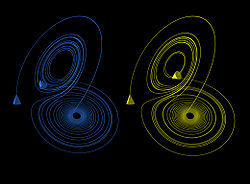Butterfly effect
The butterfly effect is an idea from chaos theory. A small change can sometimes make much bigger changes happen.[1] One small incident may have a big impact on the future. The emphasis here is on the words may and can. There is no general theory which tells us what is going to happen.
Weather and events are hard to forecast, but that doesn't mean when a butterfly flaps its wings in Tokyo and Arsenal lose a match in the English Premier League. That's just silly and impossible. However, what seem to be tiny changes in a planet's orbit can and do cause big changes to the weather: see Milankovich cycle.
Author Ray Bradbury wrote the short story "A Sound of Thunder" with this idea— time travelers make a very small change in the past that makes a large change in the present.[2] However, remember that time travel is impossible, or at least has never been shown to be possible.
Butterfly Effect Media
Experimental demonstration of the butterfly effect with six recordings of the same double pendulum. In each recording, the pendulum starts with almost the same initial condition. Over time, the differences in the dynamics grow from almost unnoticeable to drastic.
A Battus polydamas butterfly in Brazil
A plot of Lorenz' strange attractor for values ρ=28, σ = 10, β = 8/3. The butterfly effect or sensitive dependence on initial conditions is the property of a dynamical system that, starting from any of various arbitrarily close alternative initial conditions on the attractor, the iterated points will become arbitrarily spread out from each other.
Related pages
References
- ↑ Lorenz, Edward N. 1963. Deterministic nonperiodic flow. Journal of the Atmospheric Sciences 20 (2): 130–141. [1]
- ↑ Brett M. Rogers; Benjamin Eldon Stevens, eds. (2015). Classical traditions in science fiction. Oxford University Press. ISBN 978-0-19-022833-0. Retrieved June 3, 2020.



